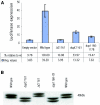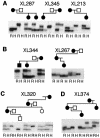Atypical forms of incontinentia pigmenti in male individuals result from mutations of a cytosine tract in exon 10 of NEMO (IKK-gamma)
- PMID: 11179023
- PMCID: PMC1274488
- DOI: 10.1086/318806
Atypical forms of incontinentia pigmenti in male individuals result from mutations of a cytosine tract in exon 10 of NEMO (IKK-gamma)
Abstract
Familial incontinentia pigmenti (IP [MIM 308310]), or Bloch-Sulzberger syndrome, is an X-linked dominant and male-lethal disorder. We recently demonstrated that mutations in NEMO (IKK-gamma), which encodes a critical component of the NF-kappaB signaling pathway, were responsible for IP. Virtually all mutations eliminate the production of NEMO, causing the typical skewing of X inactivation in female individuals and lethality in male individuals, possibly through enhanced sensitivity to apoptosis. Most mutations also give rise to classic signs of IP, but, in this report, we describe two mutations in families with atypical phenotypes. Remarkably, each family included a male individual with unusual signs, including postnatal survival and either immune dysfunction or hematopoietic disturbance. We found two duplication mutations in these families, at a cytosine tract in exon 10 of NEMO, both of which remove the zinc (Zn) finger at the C-terminus of the protein. Two deletion mutations were also identified in the same tract in additional families. However, only the duplication mutations allowed male individuals to survive, and affected female individuals with duplication mutations demonstrated random or slight skewing of X inactivation. Similarly, NF-kappaB activation was diminished in the presence of duplication mutations and was completely absent in cells with deletion mutations. These results strongly indicate that male individuals can also suffer from IP caused by NEMO mutations, and we therefore urge a reevaluation of the diagnostic criteria.
Figures



Comment in
-
Female patient showing hypohidrotic ectodermal dysplasia and immunodeficiency (HED-ID).Am J Hum Genet. 2001 Sep;69(3):664-6. doi: 10.1086/323003. Am J Hum Genet. 2001. PMID: 11484156 Free PMC article. No abstract available.
References
Electronic-Database Information
-
- Online Mendelian Inheritance in Man (OMIM), http://www.ncbi.nlm.nih.gov/Omim (for IP [MIM 308310]; for X-linked anhidrotic ectodermal dysplasia [MIM 305100]; for autosomal recessive hypohidrotic ectodermal dysplasia [MIM 224900]; for autosomal dominant hidrotic ectodermal dysplasia [MIM 129500]; for primary congenital lymphedema [MIM 153100]); for Partington syndrome II [MIM 301220]; and for Goltz syndrome [MIM 305600])
References
-
- Barkett M, Gilmore TD (1999) Control of apoptosis by Rel/NF-kappaB transcription factors. Oncogene 18:6910–6924 - PubMed
-
- Dahl MV, Matula G, Leonards R, Tuffanelli DL (1975) Incontinentia pigmenti and defective neutrophil chemotaxis. Arch Dermatol 111:1603–1605 - PubMed
-
- DiDonato JA, Hayakawa M, Rothwarf DM, Zandi E, Karin M (1997) A cytokine-responsive IkappaB kinase that activates the transcription factor NF-kappaB. Nature 388:548–554 - PubMed
Publication types
MeSH terms
Substances
Grants and funding
LinkOut - more resources
Full Text Sources
Other Literature Sources
Miscellaneous

